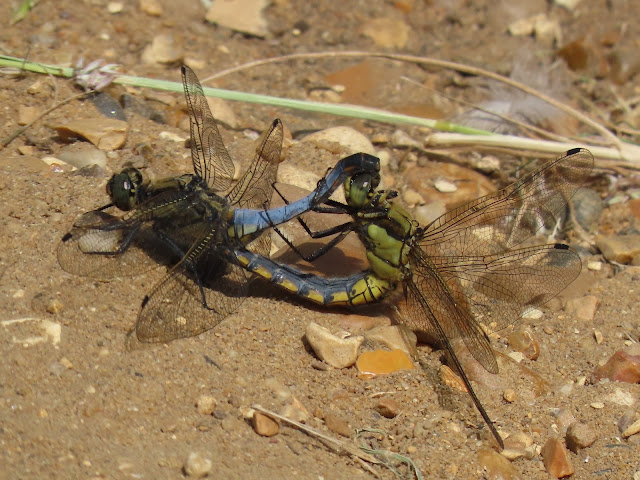I began the last week of March with a trip down to the Wetland Centre, timing my journey just right to arrive one minute before the doors open. It was a lovely sunny day and I was hoping for some migrants to be about. However, it was surprisingly quiet with just three Chiffchaffs and a solitary Blackcap singing. I did get my first proper summer migrant though with four Sand Martins whizzing around in front of the nest bank. A pair of Shelduck was also new for my site year list but the Oystercatchers eluded me and weew probably on the river as it was low tide.
.JPG) |
| Shelduck |
Around the reserve there were four Little Egrets, the most I’ve seen here as they’re fairly scarce in the inner boroughs. It was obvious that they’re still unusual here as one of the Crows seemed fascinated by this white bird and kept sneaking behind it to try and yank a feather. The egret put up with this mischief for a few minutes then it had enough and flew to a different area.
.JPG) |
| Little Egret with mischievous Crow |
On the return route, someone had baited a bench with food and a Jay decided it was too good an opportunity to miss.
.JPG) |
| Jay |
On the way home I walked through Brompton Cemetery near Earls Court which I’d not been to before. There’s a lot of mature trees and scrub and looks like it has potential but my quick visit only produced common birds.
The following day was my usual Friday visit to Rainham. Hoping again for some new migrants but despite the seemingly good conditions there was nothing on offer. The four Barnacle Geese were still on Wennington and a Water Pipit flew past calling. There were a few waders in Aveley Bay and the only uncommon birds on the reserve were two Egyptian Geese and a Green Woodpecker but it was still a nice day out.
I did Brent Reservoir for the rest of the week. Saturday produced the most unexpected bird, out of the clear blue sky a Sandwich Tern just dropped in for a few minutes before continuing its northerly migration. This was Brent’s first proper summer migrant and was such an outsider that nobody forecast it. Hardly surprising it was a long shot as there’s no other March records. Still it increased my London year list by one and not one that can be guaranteed as I missed it last year.
Chiffchaffs and Blackcaps continued to increase locally in the fine weather but they weren’t accompanied by any other new migrants. Elsewhere in London, Garganeys were turning up and just sporadic other migrants like Wheatear, Sedge Warbler and Common Whitethroat but I’m happy to wait until I run into them next month.
I had one final excursion this month, popping down to Richmond Park for the Lesser Spotted Woodpecker which was being seen quite regularly in Sawpit Plantation. It didn’t take too long for me to get there via the North London line to Richmond. I walked across the park and found the right area. It would be almost impossible to locate this bird unless I heard it and fortunately it started drumming just four minutes after I arrived. There was a lot of woodpecker activity in the park and I had already heard a few Great Spots so immediately picked up the longer and more rapid drum. I tracked it down to a few trees and started to scan with the bins and soon found it on the main trunk. I was even lucky enough to grab a quick photo before it moved on. I left it in peace and popped down to Pen Ponds to have a look before slowly making my way back up to the station and home.
.JPG) |
| Lesser Spotted Woodpecker |
.JPG) |
| Deer |
.JPG) |
| Grey Heron |
.JPG) |
| Jackdaw |
The month ended on what felt like the coldest day of the year and there was even a little snow shower. Not much chance of migrants I was thinking until I saw a couple of hirundines low over the water at the far end of the reservoir. Luckily they came closer and turned into two Sand Martins and a Swallow, definitely proving the old adage that one Swallow doesn’t make a summer.
I finished March on 129 species for my London year list, just one shy of my target and looking forward to April and shed loads of summer migrants!
.JPG)
.JPG)
.JPG)
.JPG)
.JPG)
.JPG)
.JPG)
.JPG)
.JPG)
.JPG)
.JPG)
.JPG)
.JPG)
.JPG)






























